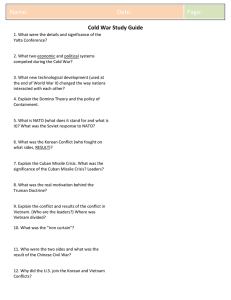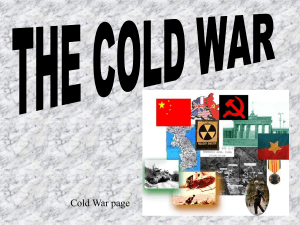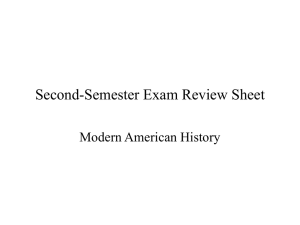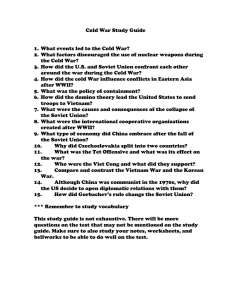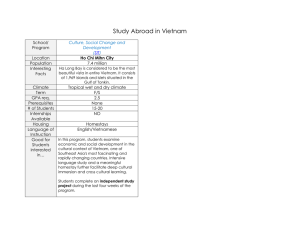THE COLD WAR 1945-1990
advertisement
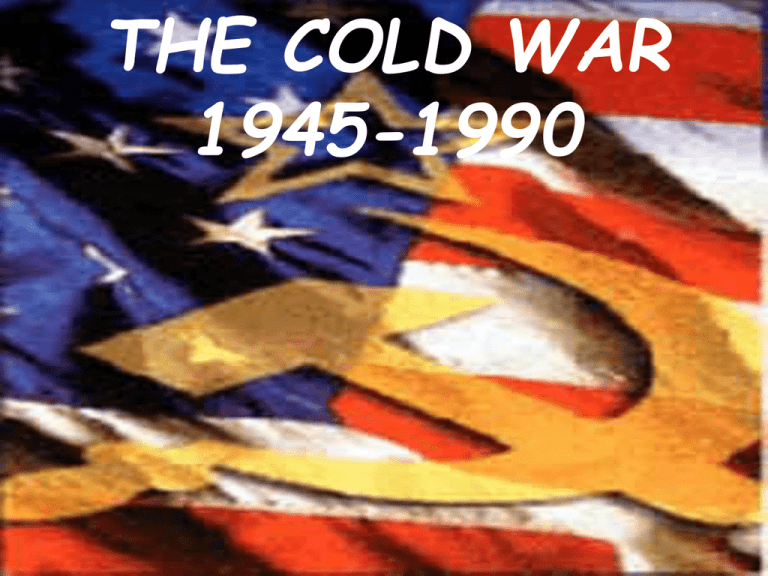
THE COLD WAR 1945-1990 The period of time from 1945 to 1989 was known as the Cold War (end of WWII to fall of the Berlin Wall). This was a time of tremendous paranoia about communism--history has been affected by this paranoia since 1945. The COLD WAR was a struggle between the forces of democracy and communism (between the individual and the state). It also included a massive buildup of nuclear weapons and threatened use of these weapons. The Cold War was also a war of WORDS (everyone hoped it wouldn’t go beyond words). The Cold War, in other words, was a war of propaganda in which the United States and its allies stood against the beliefs of the Soviet World Nations (usually the poorer nations). The Cold War ended only when communism in the Soviet Union and Eastern Europe began to fall apart in the late 1980s. 3 The Cold War (democracy v. communism) continued from 1945 through the 50s, into the 60s & 70s, and until the end of the 80s. In the early 50s, this cold war turned hot – we called this the Korean War. It turned hot again in 1965 – we called this the Vietnam War. It is the longest war (1965-1973) in American History and the only war that America lost. 4 Also keep in mind that although the war didn’t start until 1965, the U.S. had been deeply involved since the early 50s. There have been FOUR presidents influenced by the Vietnam War – Eisenhower, Kennedy, Johnson, & Nixon. One president’s administration was destroyed by Vietnam (Johnson) while one president received applause for getting us out of this war (Nixon). Two SUPERPOWERS Face Off Cold War: war of words between democratic US and Communist Russia; 1950-1990; ended with the fall of Berlin Wall 1. Soviet Union – wanted to keep the neighboring German countries weak; believed that communism was a superior economic system and should replace capitalism. 2. U.S. – wanted to promote economic growth by increasing world trade; wanted to promote democracy and free enterprise Creation of the United Nations • International Organization intended to protect the members against aggression • It was based in New York • 50 nations pledged “to save succeeding generations from the scourge of war” Superpower Aims in Europe • • • • United States Encourage democracy in other countries to help prevent the rise of communist governments Gain access to raw materials and markets to fuel booming industries Rebuild European governments to promote stability and create new markets for American goods Reunite Germany to stabilize it and increase the security of Europe • • • • Soviet Union Encourage communism in other countries as part of a worldwide worker’s revolution Rebuild its war-ravaged economy using Eastern Europe’s industrial equipment and raw materials Control Easter Europe to protect Soviet borders and balance the US influence in Western Europe Keep Germany divided to prevent its waging war again Iron Curtain Divides East and West Non-Communist countries * Churchill’s phrase “Iron Curtain” came to represent Europe’s division b/w mostly democratic Western Europe and a Communist Eastern Europe. • Relations continued to worsen in ’46 and ’47. So Truman adopted a policy of containment: stop the spread of communism by creating alliances & helping weak countries to resist the SU Communist Countries Satellite nations: • The satellite nations are the regions between Germany and Russia that were formed with the assistance of the UN after the end of WWII. However, Stalin and the communist Soviet Union took these regions over and operated them under a dictatorship. This is the region that Winston Churchill was talking about when he made his "iron curtain" speech. • Virtually all the members of the Warsaw Pact (Poland, Czechoslovakia, Hungary, Bulgaria, etc.) were basically just satellite states of Moscow; in other words, they had to run by all of their decisions with the Soviets in Moscow before they could be implemented. Marshall Plan • B/C most of Western Europe laid in ruins after the war and there was many problems (record-breaking cold and snow, rise in unemployment, lack of food, economic turmoil) • June 1947 • America gives aid to any European country that needed it: food, machines, other materials: restore the economic stability of European nations after World War II. Cold War and a Divided World • Berlin Airlift • NATO (North Atlantic Treaty Organization): 1949 – a defensive military alliance formed by 10 Western European nations, the US, and Canada – for the US, it marked the country’s first peacetime military commitment; The SU saw this as a threat • Warsaw Pact: The Warsaw Pact sought to create a military alliance between the Soviet Union and various Eastern European nations. • Nuclear Threat Space Race • Nonviolent aspect of cold war rivalry The SU: • Announcement of 1st ICBM – in Aug 1957 – 1957: Sputnik, first satellite – 1961: Yuri Gagarin orbits space’ • When the Soviet Union launched the Sputnik I satellite in 1957, many Americans feared that the Soviet Union was ahead of the U.S. in the production of missiles. The US: • 1969 – US sets up NASA, lands Apollo XI on the moon Man on moon 3:13 The Korean War: “Forgotten War” October 1949: China falls to communism – The victorious communists established the People’s Republic of China Also China and the Soviet Union signed a treaty of friendship and alliance. • The Soviet Union supported communist North Korea • The U.S. along with the UN supported democratic South Korea – WHY? To stop the spread of communism NK – communist SK - democratic NORTH KOREAN VICTORY June 25, 1950 – * NK invades SK along the 38th parallel with 90,000 troops * NK v. UN By August, the UN forces are pushed down to Pusan Perimeter INCHON INVASION MacArthur’s amphibious attack is successful By Nov– Gen. MacArthur’s Amphibious Attack took the NK’s by surprise pushing them north beyond the 38th parallel close to the Yalu River CHINESE SURPRISE November 26, 1950 – China enters the war with ½ million soldiers, who cross the Yalu River pushing the Americans and SK’s south of the 38th parallel . . . At home . . . 1951 . . . Pres. Truman vs. GenMacArthur •Truman fires MacArthur for insubordination in April 1951 after the general’s persistence in expanding the war and bomb China STALEMATE 1951-53 July 27, 1953: Armistice is signed More than 33,600 soldiers died in action; 20,600 died of accidents/diseases Today: about 40,000 American troops guard the DMZ on the 38th parallel Cuba • Fidel Castro (1926-), 1959 revolution • Cancels promised elections, expropriates foreign properties, kills or exiles political enemies • US imposes trade embargo • Soviets step in with massive aid, gain foothold off US shores The Bay of Pigs • Castro declares undying allegiance to Soviet foreign policy, 1960 • Kennedy and CIA send 1,500 Cubans into Bay of Pigs to spur revolution • American Air support does not appear, force destroyed in 3 days • US embarrassment Cuban Missile Crisis • October 1962 Soviets begin assembling missiles in Cuba • Kennedy publicly challenges USSR • Quarantines CUBA • Soviets concede, but US guarantees non-interference with Castro regime • US Secretary of State Dean Rusk: “Eyeball to eyeball, they blinked first” The Civil Rights Movement • Irony of American “freedom,” exploited by USSR propaganda • Influence of Ghandi on Martin Luther King Jr. (1929-1968) • Gradual successes: – Brown vs. Board of Education, 1954, against school segregation – Rosa Parks, Montgomery Alabama, 1955 It Only Takes One Person, Doing One Small Thing, To Change The World Rosa Parks died on October 24, 2005 at the age of ninety-two. 3. Martin Luther King Jr. leads the Montgomery Bus Boycott. a. believed in non-violent passive resistance (adopted Mohandas Gandhi’s philosophy) b. became president of the SCLC – Southern Christian Leadership Conference (African American churches played an important role since they supported boycotts, nonviolent demonstrations, and voter registration) 4. Crisis in Little Rock * Sept. 1957 – the school board in Little Rock, Arkansas, won a court order to admit 9 African American students to Central High School Elizabeth Eckford making her way to Little Rock Central High School September 6, 1957. B. The Freedom Riders – Birmingham, AL. since interstate bus service remained segregated in the South, freedom riders wanted to draw attention to segregation in Southern bus terminals F. The March on Washington -- Dr. King delivered his “I have a Dream” speech-August 28, 1963, +20k demonstrators of all races peacefully flocked to the nation’s capital C. Malcolm X -- became a symbol of black power D. Black Panthers 1968 Olympics Mexico City, MX The People’s Republic of China • Civil war between Communists and Nationalists erupts after defeat of Japan • Jiang Jieshi (Chang Kai-shek) forced to retreat to island of Taiwan with Nationalist forces – Takes most of China’s gold reserves • Mao Zedong proclaims People’s Republic of China, 1949 – Begins dramatic transformation of Chinese society into Communist mold THE VIETNAM WAR: 1965-1973 * US defends South Vietnam to stop the spread of communism The Cold War (democracy v. communism) continued from 1945 through the 50s, into the 60s & 70s, and until the end of the 80s. In the early 50s, this cold war turned hot – we called this the Korean War. It turned hot again in 1965 – we called this the Vietnam War. It is the longest war (19651973) in American History and the only war that America lost. Also keep in mind that although the war didn’t start until 1965, the U.S. had been deeply involved since the early 50s. There have been FOUR presidents influenced by the Vietnam War – Eisenhower, Kennedy, Johnson, & Nixon. One president’s administration was destroyed by Vietnam (Johnson) while one president received applause for getting us out of this war (Nixon). The North Vietnamese had been fighting invaders for many years. Before WWII, Indochina (Vietnam/Cambodia/Laos) was controlled by the French. The Japanese invaded Indochina during WWII. When the Japanese were defeated, the Vietnamese turned on the French and fought them from 1946-1954 (French-Vietnam War). The French lost and the AMERICANS DID NOT LEARN FROM THEIR EXAMPLE. Thus, America becomes involved in its own Vietnam War in 1965. The Vietnam War was a war where America backed South Vietnam which unfortunately was a corrupt government not supported by many of its own people. We were NOT trying to defeat North Vietnam, but rather just to stop the spread of communism into South Vietnam. America lost the war because of our limited goals and we were in Vietnam too long without clear-cut victories. As time dragged on, and too many American boys came home in body bags, anti-war protests grew in number. Background . . . Before WWII * Indochina was controlled by Japan. ---- Indochina: Vietnam + Laos+ Cambodia • Early 1900s, nationalism had become a powerful force in Vietnam • The nationalist leader was Ho Chi Minh -- an advocate of communism -- organized the Vietminh (nationalist group) THE U.S. GETS INVOLVED IN THEIR OWN VIETNAM WAR The Vietnam War is the first war the U.S. lost. WHY???? 1- The Vietnam War was a war in which massive American technology was lost to a SMALL DETERMINED North Vietnamese. 2- The U.S. supported South Vietnam which had a corrupt government with really bad leaders. 3- The U.S. was NOT fighting a total war, but instead was trying to stop the spread of communism. 4- More and more Americans turned against the war as the years and the body bags piled up. These are several reasons why we lost the war. Guerilla Warfare (hit-and-run): this is how the North Vietnamese fought the war 1. Who is the enemy? NV did not wear uniform, they wore civilian clothes. In Vietnam, it was difficult for the Americans to figure out who the enemy was VIETCONG (had two advantages over the US forces) a. The VC knew the terrain (mountains, jungle) b. They had the support of many South Vietnamese peasants who provided them w/food and shelter and kept them informed of U.S. troop movement. The enemy could be anywhere – he/she could be anywhere!! UNDERSTAND THE ENEMY IS UNKNOWN!! Firefights Hit-and-run tactics Booby traps - punji stakes - bouncing betty - claymore - tunnels THE AMERICAN SIDE: This is how the Americans fought the war. Massive technology lost -- Gen. William Westmoreland 1. Search and Destroy (didn’t always work) 2. Hueys 3. B-52s 4. Napalm 5. Agent Orange 68 My Lai Massacre (South Vietnamese City) March 16, 1968: My Lai was situated in a heavily mined region where VC guerrillas were firmly entrenched and numerous members of the participating platoon had been killed/mutilated during the preceding month. Lt. William Calley led his men on a search-and – destroy mission. They found women, children, and old men. **Frustrated by the unanswered loses due to snipers & mines, the soldiers took out their anger on the villagers. The company slaughtered the entire village (200-700 unarmed) Détente Reduction in hostility between nuclear superpowers Strategic Arms Limitations Talks (1972, 1979) Friction in early 1980s over improvement in relations between US and China Also, USSR intervention in Afghanistan Earlier US intervention in Vietnam 71 Copyright © 2006 The McGraw-Hill Companies Inc. Permission Required for Reproduction or Display. Collapse of the Soviet Union • Reforms under Gorbachev – Economic – Social • Perestroika: “restructuring” • Glasnost: “openness” • Nationalist sentiments, long suppressed, come to the surface • Several non-Russian republics secede, August 1991 • Attempted hardliner takeover in Moscow fails, Soviet Union collapses by end of the year Fall of Berlin Wall Built in 1961; Wall separating democratic Germany from Communist Germany, falls Nov. 9, 1989.
